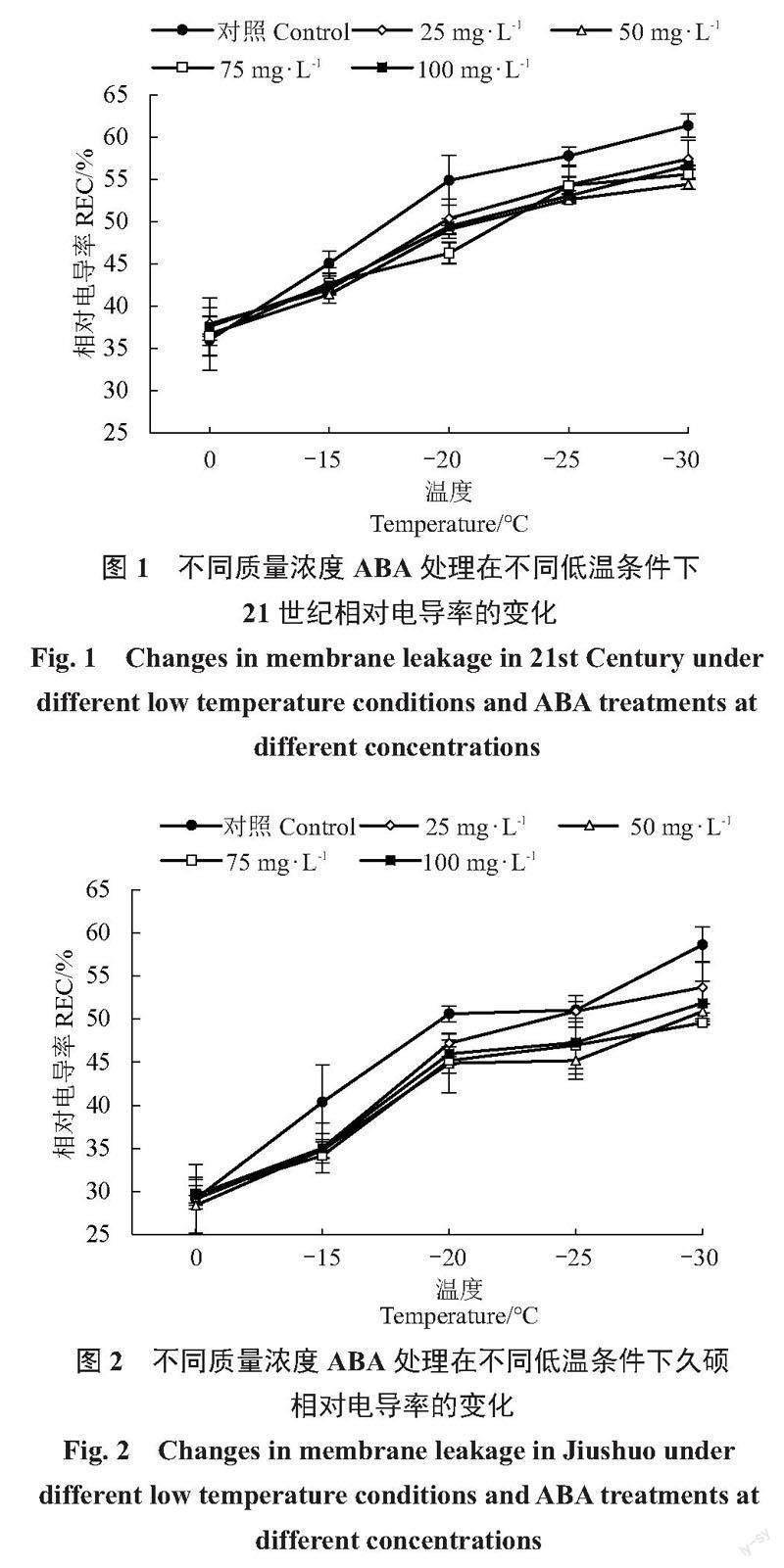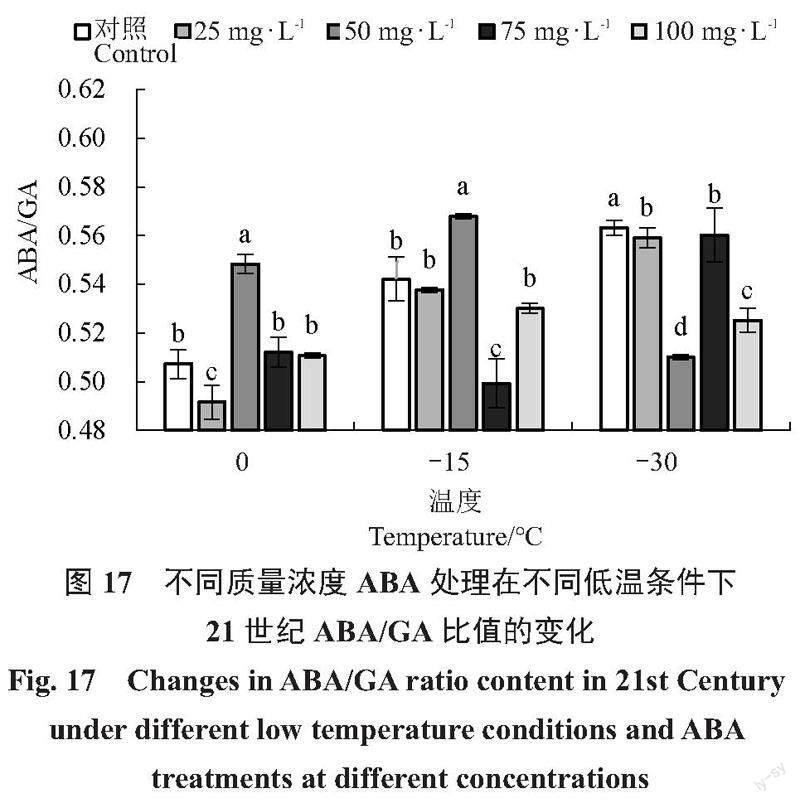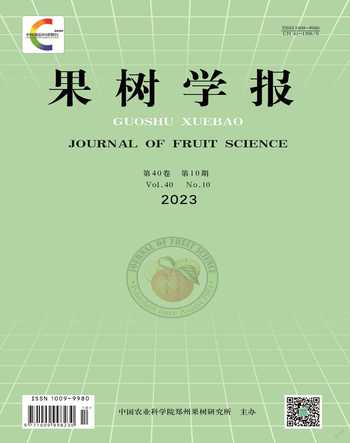外源ABA对低温胁迫下21世纪与久硕桃枝条抗寒性的影响
梁刚 赵崇宇 苏凯 刘春生 肖坤 李刚 武军凯 肖啸 张立彬 张晨光



DOI:10.13925/j.cnki.gsxb.20230247
摘 要:【目的】探明外源ABA處理对桃抗寒性的影响。【方法】以不同质量浓度ABA(0、25、50、75、100 mg·L-1)喷施处理的21世纪和久硕1年生枝条为试验材料,分别进行人工模拟低温(0、-5、-10、-15、-20、-25、-30 ℃)处理,研究相对电导率和丙二醛(MDA)、可溶性蛋白、可溶性糖及内源激素(ABA、GA、IAA、CTK)含量以及ABA/GA的差异。【结果】在低温胁迫下,外源ABA处理的21世纪和久硕枝条可溶性蛋白、可溶性糖含量较对照均增加,丙二醛(MDA)含量和相对电导率均降低,ABA、GA、IAA、CTK含量及ABA/GA均呈无规律变化。用隶属函数法对低温胁迫下各项抗寒指标进行综合评价,不同ABA质量浓度对21世纪抗寒影响顺序为50>75>100>25>0 mg·L-1(CK),不同ABA质量浓度对久硕抗寒影响顺序为50>25>75>100>0 mg·L-1(对照)。【结论】50 mg·L-1ABA为最佳质量浓度,能有效缓解冻害,提高抗寒性。
关键词:桃;外源ABA;低温胁迫;隶属函数;抗寒性
中图分类号:S662.1 文献标志码:A 文章编号:1009-9980(2023)10-2136-13
Effect of exogenous ABA on the cold resistance of branches of 21st Century and Jiushuo peaches
LIANG Gang, ZHAO Chongyu, SU Kai, LIU Chunsheng, XIAO Kun, LI Gang, WU Junkai, XIAO Xiao, ZHANG Libin, ZHANG Chenguang*
(College of Horticulture Science and Technology, Hebei University of Science and Technology/Key Laboratory of Horticultural Germplasm Resources Discovery and Innovative Utilization, Hebei Province/Research and Development Center of Biological Breeding Application Technology of Horticultural Plants with Special Characteristics in Hebei University, Qinhuangdao 066000, Hebei, China)
Abstract: 【Objective】 This experiment was conducted to explore the effect of exogenous ABA treatments on peaches under low temperature stress in Qinhuangdao City, Hebei Province, China, in order to screen the optimal concentration for improving cold resistance. 【Methods】 In this study, annual branches of 21st Century and Jiushuo treated with different concentrations of ABA (0, 25, 50, 75 and 100 mg·L-1) were used as test materials for evaluation of cold resistance under different artificial low temperatures (0, -5, -10, -15, -20, -25, and -30 ℃). Relative electrical conductivity (REC) was determined with the method of Li Hesheng. MDA was determined with Thiobarbituric acid method using the kit was provided by Shanghai Enzyme Link Biotechnology Co. Ltd.; soluble protein content was determined with a BCA protein method kit (Shanghai Enzyme Link Biotechnology Co. Ltd.); and soluble sugar content was determined with plant soluble sugar kit (Shanghai Enzyme Link Biotechnology Co. Ltd.). The endogenous hormones of ABA, GA, IAA and CTK were determined using ELISA method with kits provided by Shanghai Enzyme Biotechnology Co. Ltd.. The differences in relative conductivity, MDA, soluble protein, soluble sugar and endogenous hormones (ABA, GA, IAA, CTK and ABA/GA) were investigated. 【Results】 The results showed that under low temperature stresses, the soluble protein and soluble sugar contents in 21st Century and Jiushuo branches treated with exogenous ABA increased compared with the control. 50 mg·L-1 ABA treatment had the highest increase compared with the control. MDA and relative conductivity increased slowly compared with the control. The contents of ABA, GA, IAA, CTK and ABA/GA ratio increased first and then decreased. The endogenous ABA content in 21st Century at 0 ℃ was the highest in the 75 mg·L-1 treatment and increased by 6.9% compared with the control; at -15 ℃, the highest ABA content was found in the 25 mg·L-1 treatment, which increased by 2.1% compared with the control; at -30 ℃, the highest ABA content was found in the 25 mg·L-1 treatment, which increased by 2.6% compared with the control. The ABA content in Jiushuo was the lowest in the 100 mg·L-1 treatment at 0 ℃, which was 5% lower than the control; the lowest ABA was found in the 50 mg·L-1 treatment at -15 ℃ and at -30 ℃, which was 9.1% and 7.4% lower than the control, respectively. The GA content in 21st Century was the lowest in 50 mg·L-1 treatment at 0 ℃, which was 3.8% lower than the control; the lowest GA content was found in 50 mg·L-1 treatment at -15 ℃, which was 3.2% lower than the control; GA content in 75 mg·L-1 treatment at -30 ℃ increased slightly and was 1.5% higher than in the control. The GA content in Jiushuo was the lowest in 75 mg·L-1 treatment at 0 ℃, which was 6.5% lower than the control at -15 ℃; the lowest GA content was found in 25 mg·L-1 treatment, which was 0.1% lower than the control at -30 ℃; the GA content in 25 mg·L-1 and 100 mg·L-1 treatments was increased slightly and was 0.7% higher than the control. The endogenous IAA content in 21st Century was the lowest in 25 mg·L-1 treatment at 0 ℃, about 2.9% lower than the control. At -15 ℃, the lowest IAA content was found in 100 mg·L-1 treatment, which was 4.2% lower than the control. At -30 ℃, the IAA content of the sample treated with 50 mg·L-1 ABA is less than 1% higher than the control. IAA content in Jiushuo was the lowest in 50 mg·L-1 treatment at 0 ℃, which was 4.8% lower than the control; at -15 ℃, the lowest IAA content was in 75 mg·L-1 treatment, which was 3.7% lower than the control; and at -30 ℃ the lowest IAA was found in 100 mg·L-1 treatment at, which was 1.5% higher than the control. In 21st Century, endogenous CTK content at 0 ℃ was found in the 100 mg·L-1 treatment, which increased 0.4% compared to the control; at -15 ℃, the lowest CTK content was found in the 100 mg·L-1 treatment, which increased 2.2% compared to the control; at -30 ℃, the lowest CTK content was found in the 100 mg·L-1 treatment, which decreased by 9.3% compared with the control. The endogenous CTK content of Jiushuo was the lowest in the 50 mg·L-1 treatment at 0 ℃, with an increase of 2.5% compared with the control; at -15 ℃, the lowest CTK was found in the 50 mg·L-1 treatment, with a decrease of 1.8% compared with the control; and the lowest CTK was in the 100 mg·L-1 treatment at -30 ℃, with a decrease of 7.9% compared with the control. In 21st Century, ABA/GA ratio at 0 ℃. 50 mg·L-1 treatment had the highest ABA/GA ratio, which 8.1% hgiher compared with the control; At -15 ℃, the ABA/GA ratio of 50 mg·L-1 treatment was the highest, increasing by 4.7% compared to the control; At -30 ℃, the ABA/GA ratio of 75 mg·L-1 treatment was the highest among all treatment groups, but it was 0.5% lower than the control group. The ABA/GA ratio of Jiushuo was the highest in the 75 mg·L-1 treatment at 0 ℃, with 4% increase over the control; the highest ABA/GA ratio was found in the 25 mg·L-1 treatment at -15 ℃; and the highest ABA/GA ratio was in the 25 mg·L-1 treatment at -30 ℃. At -30 ℃, the highest ABA/GA ratio was observed in the 25 mg·L-1 treatment, with an increase of 1.8% compared with the control. The cold resistance indexes under low temperature stress were comprehensively evaluated by the affiliation function method, and the order of cold resistance among ABA treatments for 21st Century was 50 mg·L-1>75 mg·L-1>100 mg·L-1>25 mg·L-1>0 mg·L-1 (control); for Jiushuo, the order was 50 mg·L-1>25 mg·L-1>75 mg·L-1>100 mg·L-1>0 mg·L-1 (control). 【Conclusion】 ABA treatment could affect the cold resistance of 21st Century and Jiushuo to different degrees. Based on the changes in physiological indexes, 50 mg·L-1 ABA treatment is the best, as it effectively alleviated frost damage and improve cold resistance.
Key words: Peach; Exogenous ABA; Low temperature stress; Affiliation function; Cold resistance
桃属蔷薇科李属桃亚属落叶果树,起源于中国西部[1],具有较高的经济价值。其主要栽培范围集中在我国北方地区,而北方地区冬季气候严寒,使桃树经常遭受低温冻害和早春霜害侵袭,严重时造成树体死亡,给桃树生长发育和产业发展造成严重影响[2]。给果树喷施相关激素是提高果树抗寒力常用农业措施,对抗寒育种、产业发展有着重要意义。目前研究较多的是脱落酸(abscisic acid,ABA),它是植物五大激素之一,可响应逆境胁迫,提高植物抗逆性[3]。有相关试验报道外施ABA可代替低温锻炼,能提高植物抵抗低温的能力[4]。近年来,大量研究表明利用外源ABA喷施处理植株是提高植物抗寒性的有效方法。徐琛[5]在低温胁迫对冬小麦膜质抗寒性影响的研究中,发现外源ABA处理均使小麦电导率、丙二醛(malondialdehyde,MDA)含量显著降低。项洪涛等[6]对水稻研究发现外源ABA处理均降低MDA含量和相对电导率,促进可溶性糖、可溶性蛋白、脯氨酸含量和保护酶活性提高。黄杏[7]在甘蔗中研究发现外源ABA处理后,能有效缓解低温带来的不利效应,降低MDA和赤霉素(gibberellic acid, GA)含量,提高脯氨酸、ABA含量和ABA/GA比值,从而提高抗寒性。伍宝朵等[8]研究发现外源ABA处理可提高胡椒抗氧化酶活性、降低H2O2和MDA含量以缓解低温对其光系统活性的伤害,从而提高胡椒抵抗低温胁迫的能力。
本研究于中国河北省秦皇岛市昌黎县进行,2018—2022年间冬季最低温为-21 ℃(来源于全球天气网)。在桃树未进入休眠前,通过对21世纪和久硕桃树进行不同质量浓度ABA喷施处理,待树体进入休眠后采集1年生枝条,人工模拟不同低温处理,研究不同质量浓度ABA对枝条相对电导率和丙二醛(MDA)、可溶性蛋白、可溶性糖及内源激素脱落酸(ABA)、赤霉素(GA)、生长素(indoleacetic acid,IAA)、细胞分裂素(cytokinin,CTK)含量及ABA/GA的影响。采用隶属函数法进行综合评价,筛选出最佳ABA处理质量浓度,为喷施ABA提高桃树抗寒性提供参考依据。
1 材料和方法
1.1 试验材料
以21世纪和久硕桃为试验材料,定植于河北省秦皇岛市昌黎县河北科技师范学院石桥营基地桃种质资源圃(119°23′ E,39°73′ S)。
1.2 试验处理
1.2.1 外源ABA处理 2022年9月27日下午,天气晴朗无风,桃树还未进入落叶期(10月底11月初落叶期)。选取树龄一致,树体大小相近且生长势旺盛的桃树进行区域分组,同一品种3株相邻树为1组,一共2个品种10组(30株树),每组之间间隔1株树,防止喷雾飘散的影响。用不同质量浓度ABA(0、25、50、75、100 mg·L-1)对每组喷施处理。0 mg·L-1为清水处理,记为对照,每个ABA质量浓度对应一个组进行喷施,树叶滴水为宜。2022年10月6日下午,天气晴朗无风,以同样方法进行第二次喷施处理。等到桃树完全落叶,进入休眠期后,取样。ABA处理后的桃树落叶期均较对照提前2~4 d。
1.2.2 低温胁迫处理 2022年11月17日,随机选取ABA处理后树冠外围和中部生长健壮、大小、粗度相似且无病虫害的1年生枝条,每组取30枝,做好标记带回实验室。用清水冲洗表面污渍,滤纸吸干表面水分后,每组截取枝条中部长度一致(12 cm)、粗度相似(0.3~0.6 cm)枝条,凡士林封住两端剪口,装入聚乙烯自封袋中。每组分为7份,每份15根枝条,共计10组。放入已设置好的低温冰箱中进行低温处理。设置温度为0、-5、-10、-15、-20、-25、-30 ℃ 7个低温处理,每个处理温度保持24 h。0 ℃保持24 h后,将第1组枝条取出。温度设置-5 ℃,再次保持24 h,将第2组枝条取出。以同样方法依次处理至-30 ℃,将第7组枝条取出。每个温度处理后取出枝条需放置于4 ℃冰箱,保持9 h,进行各项生理指标测定。
1.3 试验方法
1.3.1 相对电导率测定 相对电导率采用电导法[9]测定。将低温处理后枝条避开芽眼剪成0.1 cm小段,准确称取0.2 g装入50 mL锥形瓶中,加入15 mL去离子水,用封口膜封口,在室温下浸泡12 h,用电导率仪测定浸提液初始电导率(C1)。测定完成后,再次用封口膜封口,沸水浴(100 ℃)30 min杀死植物组织,冷却至室温,測定最终电导率(C2)。每个处理3次重复。相对电导率/%=C1/C2×100。
1.3.2 其他生理指标测定 丙二醛、可溶性蛋白、可溶性糖含量均参照试剂盒说明书(上海酶联生物科技有限公司)测定,试剂盒测定说明书根据实际情况略微改动。内源激素ABA、GA、IAA、CTK含量均采用酶联免疫吸附法[10](Enzyme-linked immunosorbent as-says,简称ELISA法)测定,所用测定试剂盒购自于上海酶计生物科技有限公司。每个指标测定需将处理好的样品装入96孔酶标板,放入酶标仪进行吸光值测定。
1.4 数据分析与处理
试验数据利用Microsoft Excel 2007进行处理,利用SPSS 26.0进行相关性分析和差异显著性分析。参照唐士勇[11]方法计算低温半致死温度(LT50)。运用隶属函数法计算各抗寒指标隶属度[12],若指标与抗寒性呈正相关,指标隶属度计算公式为:
Ui j=(Xi j-Xj min)/(Xj max-Xj min);
若指标与抗寒性呈负相关,指标隶属度计算公式为:
Ui j=1-(Xi j-Xj min)/(X j max-Xj min)。
式中Ui j表示i品种j指标的抗寒隶属函数值;Xi j表示i品种j指标的测定值;Xj min表示j指标的最小值;Xj max表示j指标的最大值[13-14]。
2 结果与分析
2.1 不同质量浓度ABA处理后在不同低温下枝条相对电导率变化与半致死温度(LT50)
不同质量浓度ABA处理对不同低温下21世纪和久硕相对电导率的影响见图1、图2。随着温度降低,处理质量浓度增加,21世纪和久硕枝条相对电导率总体呈上升趋势,上升速度均低于0 mg·L-1(对照)。在0~-30 ℃不同低温下,21世纪相对电导率分别增加70.5%、51.6%、48.3%、52.6%、50.7%,对照相对电导率增加最大,为70.5%,50 mg·L-1处理枝条相对电导率增加最小,为48.3%。久硕相对电导率分别增加101.2%、84.5%、79.3%、67.2%、75.3%,对照增加最大,为101.2%,75 mg·L-1处理枝条相对电导率增加最小,为67.2%。
由表1可见,不同质量浓度ABA处理21世纪和久硕的logistic方程拟合相关系数为0.811~0.951,均高于临界相关系数(r=0.707,α=0.05),拟合度较好。LT50在-17.675~-29.731 ℃之间,由LT50可得出不同质量浓度ABA对21世纪抗寒性影响的顺序50 mg·L-1>75 mg·L-1>100 mg·L-1>25 mg·L-1>0 mg·L-1;对久硕抗寒性影响的顺序为50 mg·L-1>75 mg·L-1>100 mg·L-1>25 mg·L-1>0 mg·L-1。
将处理质量浓度与相对电导率进行相关性分析,结果表明质量浓度与两品种相对电导率均呈极显著正相关(p<0.01),21世纪相关系数分别为0.953、0.935、0.932、0.967、0.975;久硕相关系数分别为0.949、0.939、0.932、0.901、0.905。
2.2 不同质量浓度ABA处理后在不同低温下对枝条丙二醛含量的影响
不同质量浓度ABA处理后在不同低温下对丙二醛含量影响见图3、图4。随着温度下降,质量浓度增加,21世纪枝条丙二醛含量呈升-降-升-降的变化趋势,久硕枝条丙二醛含量整体呈上升的变化趋势。当温度由0 ℃下降到-30 ℃时,21世纪丙二醛含量分别增加42.4%、50.0%、42.2%、43.7%、44.3%,50 mg·L-1处理枝条丙二醛含量增加较少,为42.2%。久硕丙二醛含量分别增加104.2%、85.4%、85.0%、102.7%、97.4%,50 mg·L-1处理枝条丙二醛含量增加较少,为85.0%。这些结果表明,一定质量浓度ABA处理抑制21世纪和久硕丙二醛积累,且50 mg·L-1ABA效果最佳。
将处理质量浓度与抗寒性进行相关性分析,结果表明,21世纪相关系数为0.521、0.730、0.603、0.632、0.554,均呈显著正相关(p<0.05),其中25、75、100 mg·L-1处理呈极显著正相关(p<0.01);久硕相关系数为0.828、0.808、0.850、0.877、0.843,均呈极显著正相关(p<0.01)。
2.3 不同质量浓度ABA处理后在不同低温下对枝条可溶性蛋白含量的影响
不同质量浓度ABA处理在不同低温条件下对可溶性蛋白含量的影响见图5、图6。随着温度降低,21世纪和久硕各质量浓度ABA处理后枝条可溶性蛋白含量均呈升-降-升-降-升的变化趋势。当温度由0 ℃下降到-30 ℃时,21世纪枝条可溶性蛋白含量分别增加30.5%、38.9%、39.7%、36.2%、34.2%,50 mg·L-1处理枝条可溶性蛋白含量幅度增加最大,为39.7%。久硕枝条可溶性蛋白含量分别增加59.4%、59.6%、62.3%、49.5%、54.5%,50 mg·L-1处理枝条可溶性蛋白含量增加幅度最大,为62.3%。这些结果表明一定质量浓度ABA处理促进21世纪和久硕可溶性蛋白含量积累,且50 mg·L-1ABA处理效果最佳。
将处理质量浓度与抗寒性进行相关性分析,结果表明处理质量浓度在50 mg·L-1时,21世纪枝条可溶性蛋白含量与抗寒性呈显著正相关,相关系数为0.476(p<0.05)。0 mg·L-1(对照)处理,久硕枝条可溶性蛋白含量与抗寒性呈显著正相关,相关系数为0.468(p<0.05)。25 mg·L-1处理,久硕枝条可溶性蛋白含量与抗寒性呈极显著正相關,相关系数为0.596(p<0.01)。
2.4 不同质量浓度ABA处理后在不同低温下对枝条可溶性糖含量的影响
不同质量浓度ABA处理在不同低温条件下对可溶性糖含量的影响见图7、图8。随着温度降低,不同质量浓度ABA处理21世纪枝条可溶性糖含量整体呈升-降-升-降-升的变化趋势。当温度由0 ℃下降到-30 ℃,21世纪枝条可溶性糖含量分别增加13.9%、13.1%、15.2%、7.3%、6.7%。50 mg·L-1处理可溶性糖含量增加幅度最大,为15.2%。久硕枝条可溶性糖含量整体呈升-降-升-降-升的变化趋势,可溶性糖含量分别增加13.1%、13.3%、13.6%、5.8%、4.8%,50 mg·L-1处理枝条可溶性糖含量增加幅度最大,为13.6%。这些结果表明一定质量浓度ABA处理能促进21世纪和久硕枝条可溶性糖含量积累,且50 mg·L-1ABA处理效果最佳。
2.5 不同质量浓度ABA处理后在不同低温下对枝条ABA含量的影响
不同质量浓度ABA处理在不同低温条件下对ABA含量的影响见图9、图10。21世纪整体ABA含量随着温度降低而降低。0 ℃时,ABA含量均高于对照,75 mg·L-1处理的ABA含量最高,较对照增加6.9%;-15 ℃时,25 mg·L-1处理的ABA含量最高,较对照增加2.1%;-30 ℃时,25 mg·L-1处理的ABA含量最高,较对照增加2.6%。久硕ABA含量整体随着温度降低而降低。0 ℃时,100 mg·L-1处理的ABA含量最低,较对照降低5%;-15 ℃时,50 mg·L-1处理的ABA含量最低,较对照降低9.1%;-30 ℃时,50 mg·L-1浓度ABA处理的ABA含量最低,较对照降低7.4%。
2.6 不同质量浓度ABA处理后在不同低温下对枝条GA含量的影响
不同质量浓度ABA处理在不同低温条件下对GA含量的影响见图11、图12。21世纪整体GA含量随温度降低而降低。0 ℃时,50 mg·L-1处理的GA含量最低,较对照降低3.8%;-15 ℃时,50 mg·L-1处理的GA含量最低,较对照降低3.2%;-30 ℃时,GA含量均高于对照,25 mg·L-1处理的GA含量最高,较对照增加7.6%。久硕整体GA含量随温度降低而降低。0 ℃时,整体GA含量均低于对照。75 mg·L-1处理的GA含量最低,较对照降低6.5%;-15 ℃时,75 mg·L-1处理的GA含量最高,较对照增加5%;-30 ℃时,整体GA含量均高于对照。75 mg·L-1处理的GA含量最高,较对照增加2.6%。
2.7 不同质量浓度ABA处理后在不同低温下对枝条IAA含量的影响
不同质量浓度ABA在不同低温条件下对IAA含量的影响见图13、图14。21世纪整体IAA含量随温度降低呈下降趋势。0 ℃时,25 mg·L-1处理的IAA含量最低,较对照降低2.9%;-15 ℃时,IAA含量均低于对照,整体随浓度升高呈降低趋势。100 mg·L-1处理的IAA含量最低,较对照降低4.2%;-30 ℃时,IAA含量整体均高于对照,100 mg·L-1处理的IAA的含量最高,较对照增加4.2%。久硕整体IAA含量随温度降低呈下降趋势。0 ℃时,50 mg·L-1处理的IAA含量最低,较对照降低4.8%;-15 ℃时,75 mg·L-1处理的IAA含量最低,较对照降低3.7%;-30 ℃时,IAA含量均高于对照,25 mg·L-1处理的IAA含量最高,较对照增加9.5%。
2.8 不同质量浓度ABA处理后在不同低温下对枝条CTK含量影响
不同质量浓度ABA处理在不同低温条件下对CTK含量的影响见图15、图16。21世纪整体CTK含量随温度降低而下降,呈现随着质量浓度升高先升高后降低的趋势。0 ℃时,CTK含量均高于对照。50 mg·L-1处理的CTK含量最高,较对照增加7.6%;-15 ℃時,CTK含量差异不显著;-30 ℃时,CTK含量均低于对照。100 mg·L-1处理的CTK含量最低,较对照降低9.3%。久硕整体CTK含量随温度降低而下降,随着质量浓度增加呈升-降-升-降的趋势。0 ℃时,CTK含量均高于对照,75 mg·L-1处理的CTK含量最高,较对照增加8.8%;-15 ℃时,25 mg·L-1处理的CTK含量最高,较对照增加4.3%;-30 ℃时,100 mg·L-1处理的CTK含量最低,较对照降低7.9%。
2.9 不同质量浓度ABA处理后在不同低温下对枝条ABA/GA比值的影响
不同质量浓度ABA处理在不同低温条件下对ABA/GA比值的影响见图17、图18。21世纪的ABA/GA比值随温度降低整体呈上升趋势,在0 ℃时,50 mg·L-1处理的ABA/GA比值最高,较对照增加8.1%,差异显著。-15 ℃时,50 mg·L-1处理的ABA/GA比值最高,较对照增加4.7%。-30 ℃时,ABA/GA比值均低于对照。50 mg·L-1处理的ABA/GA比值最低,较对照降低9.4%。久硕ABA/GA比值随温度降低整体呈先升后降的趋势。0 ℃时,75 mg·L-1处理的ABA/GA比值最高,较对照增加4%。-15 ℃时,25 mg·L-1处理的ABA/GA比值最高,较对照增加1.1%。-30 ℃时,25 mg·L-1处理的ABA/GA比值最高,较对照增加1.8%。
2.10 不同质量浓度ABA处理后桃枝条抗寒性综合评价
单一的指标很难全面反映植物综合抗寒能力,用多个指标评价综合能力比单一指标更为可靠[15]。运用隶属函数平均值能更全面、客观地反映不同桃品种的抗寒能力[16]。本研究中以10个抗寒指标隶属度的平均值对2个桃品种不同浓度ABA处理后枝条抗寒性进行综合评价,综合指标平均隶属值度越大,抗寒性越强,反之抗寒性越弱。结果如表2所示,21世纪枝条经过不同质量浓度ABA处理的平均隶属度值在0.504~0.514之间,平均隶属度值均比对照高,其中50 mg·L-1ABA处理的平均隶属度值最大,根据平均隶属度值大小,不同质量浓度ABA抗寒影响顺序为50 mg·L-1>75 mg·L-1>100 mg·L-1>25 mg·L-1>0 mg·L-1。久硕枝条不同质量浓度ABA处理的平均隶属度值在0.492~0.510之间,平均隶属度值均比对照高,50 mg·L-1ABA处理的平均隶属度值最大。根据平均隶属度值大小,不同质量浓度ABA抗寒影响顺序为50 mg·L-1>25 mg·L-1>75 mg·L-1>100 mg·L-1>0 mg·L-1(对照)。
3 讨 论
在自然界中,植物正常生长发育需要适宜的温度,超过致死温度就会影响植物发育甚至死亡。低温胁迫下,植物细胞膜透性增大,电解质外渗率升高,枝条组织细胞膜的功能损伤越来越严重,电导率发生变化[17]。电导率的变化能反映细胞膜受伤害程度,结合Logistis方程计算出的LT50可用于比较植物抗寒性[18]。本试验研究结果表明不同质量浓度ABA处理21世纪和久硕均能降低低温胁迫下枝条相对电导率上升速度,且50 mg·L-1处理的21世纪上升速度最小,75 mg·L-1处理的久硕上升速度最小,与孙庆玲等[19]研究结果中的狗牙根表现一致,抗寒性强的品种最适ABA浓度高于抗寒性敏感品种。
丙二醛(MDA)是膜质过氧化的最终分解产物,其含量是判断细胞膜是否被氧化的一个重要依据[20],果树上众多研究表明MDA含量随着胁迫温度降低均有不同程度增加[21-23],MDA变化可以反映果树遭受逆境伤害的程度[24]。杨晓宇[25]的研究结果表明,3个扁桃品种叶片和枝条内的MDA含量变化始终是抗寒性弱的品种晋扁2号最高,抗寒性强的品种英吉沙最低。说明MDA含量高,抗寒能力较弱,受冻害较严重;MDA含量低,抗寒能力较强,受冻害较轻。本试验中经过不同质量浓度ABA处理的21世纪和久硕在低温胁迫下枝条MDA含量均不同程度增加。50 mg·L-1处理的21世纪和久硕枝条MDA含量增加幅度最小,表明50 mg·L-1处理可以抑制枝条MDA积累,减轻毒害作用。
可溶性蛋白、可溶性糖均属于细胞渗透调节物质,负责维持细胞质与外界环境平衡,使细胞膜不受伤害。许多研究表明,渗透物质积累越多,植物抗寒性越强,反之,则弱。喷施ABA可促进植物体内渗透调节物质积累[26],从而提高抗寒性。本试验中经过不同质量浓度ABA处理的21世纪和久硕在低温胁迫下枝条可溶性蛋白、可溶性糖含量均不同程度增加,这与纪环宇等[27]研究外源ABA处理对低温胁迫下越橘花期和幼果期中可溶性糖、可溶性蛋白含量变化趋势相似。50 mg·L-1处理的21世纪和久硕枝条可溶性蛋白、可溶性糖含量增加幅度最大。表明50 mg·L-1处理可以更好促进枝条渗透调节物质积累,提高抗寒性。
内源激素(ABA,GA,IAA,CTK)对植物自身生长、发育、成熟等所有生理过程均有调控作用[28]。植物生长调节剂可直接或间接影响植物内源激素含量。前人研究发现,脱落酸(ABA)可通过正向反馈机制进一步合成ABA,增强信号转导途径,让植物更好地适应胁迫环境[29]。外施ABA能诱导植物抵御低温,有效改变植物体内激素平衡关系,使植物各项生理指标发生变化,提高抗寒性[30-31]。王兴等[32]在自然条件下对不同抗寒性冬小麦的研究指出,抗寒性强的东农冬麦1号各器官中的ABA、ZR、IAA含量均高于抗寒性弱的济麦22,对冬小麦安全越冬起重要作用的内源激素是ABA。有报道说明ABA/GA更能代表植株抗寒性强弱[33],罗正荣等[34]研究指出,植物膜透性半致死温度与叶片内ABA/GA比值呈线性相关,ABA/GA比值高,抗寒力增强;ABA/GA比值降低,则抗寒力下降。说明植株体内多种激素不同配比也能调节抗寒性[35]。本试验中不同质量浓度ABA处理的21世纪和久硕在低温胁迫下枝条内源激素(ABA、GA、IAA、CTK)含量均出现不同变化,且无显著变化规律。ABA/GA比值则总体呈上升趋势,与杨文莉等[36]研究外源ABA對轮台白杏枝条内源激素含量影响的结果一致。
综合各项生理指标,经方差分析,除可溶性糖含量外,各指标均有显著差异性。可溶性糖含量无差异性可能是对处理浓度不敏感所致。隶属函数分析,久硕平均隶属函数值总体比21世纪的隶属函数值低,这可能是久硕本身比21世纪耐寒(试验基地中大部分21世纪桃树均受到一定的冻害,比如树干卷曲,甚至少部分出现树干冻裂现象,而久硕并未发现类似冻害现象。且两个品种桃树栽培地点相邻,均位于试验基地中部)。但自然温度下的植物生长受多种因素影响,人工模拟温度并不能完全准确反映植物抗寒性,具体有待进一步研究。
4 结 论
50 mg·L-1ABA处理21世纪和久硕的各抗寒指标显著优于对照及其他处理,效果最佳。生产上可借鉴此ABA处理质量浓度喷施桃树以抵御低温冻害。
参考文献 References:
[1] 张立彬,王印肖. 河北林木种质资源[M]. 北京:中国林业出版社,2015:231-248.
ZHANG Libin,WANG Yinxiao. Tree germplasm resources in Hebei[M]. Beijing:China Forestry Publishing House,2015:231-248.
[2] 王力荣,朱更瑞,左覃元. 中国桃品种需冷量的研究[J]. 园艺学报,1997,24(2):194-196.
WANG Lirong,ZHU Gengrui,ZUO Qinyuan. Studies on the chilling requirement of peach varieties[J]. Acta Horticulturae Sinica,1997,24(2):194-196.
[3] 玄祖迎. 滇杨(Populus yunnanensis)对增强紫外辐射、干旱和喷施脱落酸的生态生理响应[D]. 成都:中国科学院研究生院(成都生物研究所),2007.
XUAN Zuying. Ecophysiological responses of Populus yunnanensis to supplemental ultraviolet-B,drought and exogenous abscisic acid[D]. Chengdu:Graduate School of Chinese Academy of Sciences (Chinese Academy of Sciences),2007.
[4] LI C Y,JUNTTILA O,ERNSTSEN A,HEINO P,PALVA E T. Photoperiodic control of growth,cold acclimation and dormancy development in silver birch (Betula pendula) ecotypes[J]. Physiologia Plantarum,2003,117(2):206-212.
[5] 徐琛. 外源ABA对低温下冬小麦膜质抗寒性的影响[D]. 哈尔滨:东北农业大学,2014.
XU Chen. Impacts of ABA on cold resistance of membrane lipid in winter wheat under cold stress[D]. Harbin:Northeast Agricultural University,2014.
[6] 项洪涛,齐德强,李琬,郑殿峰,王月溪,王彤彤,王立志,曾宪楠,杨纯杰,周行,赵海东. 低温胁迫下外源ABA对开花期水稻叶鞘激素含量及抗寒生理的影响[J]. 草业学报,2019,28(4):81-94.
XIANG Hongtao,QI Deqiang,LI Wan,ZHENG Dianfeng,WANG Yuexi,WANG Tongtong,WANG Lizhi,ZENG Xiannan,YANG Chunjie,ZHOU Hang,ZHAO Haidong. Effect of exogenous ABA on the endogenous hormone levels and physiology of chilling resistance in the leaf sheath of rice at the flowering stage under low temperature stress[J]. Acta Prataculturae Sinica,2019,28(4):81-94.
[7] 黄杏. 外源ABA提高甘蔗抗寒性的生理及分子机制研究[D]. 南宁:广西大学,2012.
HUANG Xing. Study on physiological and molecular mechanism of cold resistance enhanced by exogenous ABA application in sugarcane[D]. Nanning:Guangxi University,2012.
[8] 伍宝朵,崔鑫,胡丽松,范睿,朱春梅,杨建峰,郝朝运. 叶面喷施外源ABA对胡椒抗寒生理生化及ABA信号转导相关基因的影响[J]. 南方农业学报,2020,51(11):2764-2772.
WU Baoduo,CUI Xin,HU Lisong,FAN Rui,ZHU Chunmei,YANG Jianfeng,HAO Chaoyun. Effects of exogenous foliar spraying ABA on genes related to cold resistance physiology,biochemistry and ABA signal transduction of black pepper[J]. Journal of Southern Agriculture,2020,51(11):2764-2772.
[9] 郭燕,张树航,李颖,张馨方,韩斌,王广鹏,杨阳. 我国几个板栗品种抗寒性综合评价[J]. 中国农业大学学报,2019,24(4):52-63.
GUO Yan,ZHANG Shuhang,LI Ying,ZHANG Xinfang,HAN Bin,WANG Guangpeng,YANG Yang. Comprehensive evaluation on the cold resistance of several main Chinese chestnut cultivars[J]. Journal of China Agricultural University,2019,24(4):52-63.
[10] 赫冬梅,胡國公,穆琳. 烟草内源激素的酶联免疫吸附法(ELISA)测定[J]. 烟草科技,2000,33(5):41-42.
HE Dongmei,HU Guogong,MU Lin. Determination of endogenous hormones in tobacco by enzyme-linked immunosorbent assay (ELISA)[J]. Tobacco Science & Technology,2000,33(5):41-42.
[11] 唐士勇. Logistic方程在果树半致死温度测定中的应用[J]. 北方果树,1993(4):23-24.
TANG Shiyong. Application of logistic equations in the determination of semi-lethal temperature of fruit trees [J]. Northern Fruits,1993(4):23-24.
[12] 张文娥,王飞,潘学军. 应用隶属函数法综合评价葡萄种间抗寒性[J]. 果树学报,2007,24(6):849-853.
ZHANG Wene,WANG Fei,PAN Xuejun. Comprehensive evaluation on cold hardiness of Vitis species by Subordinate Function (SF)[J]. Journal of Fruit Science,2007,24(6):849-853.
[13] 冯英慧,悦冲,樊保国. 山西省部分毛桃品种的抗寒性评价[J]. 江苏农业科学,2018,46(4):139-142.
FENG Yinghui,YUE Chong,FAN Baoguo. Evaluation of cold resistance of some hairy peach varieties in Shanxi Province[J]. Jiangsu Agricultural Sciences,2018,46(4):139-142.
[14] 董婧妍. 河北省桃品种冻害调查及部分品种抗寒力评价[D]. 秦皇岛:河北科技师范学院,2022.
DONG Jingyan. Investigation on freezing injury of peach varieties in Hebei Province and evaluation of cold resistance of some varieties[D]. Qinhuangdao:Hebei Normal University of Science & Technology,2022.
[15] 赵国栋,赵同生,李春敏,付友,张新生. 11个苹果野生砧木品种低温处理抗性指标的综合评价[J]. 西北林学院学报,2018,33(6):145-151.
ZHAO Guodong,ZHAO Tongsheng,LI Chunmin,FU You,ZHANG Xinsheng. Comprehensive evaluation on cold resistance of eleven wild apple rootstocks[J]. Journal of Northwest Forestry University,2018,33(6):145-151.
[16] 王召元,田启航,常瑞丰,刘国俭,陈湖,李永红. 桃不同品种对低温胁迫的生理响应及评价[J]. 中国农业大学学报,2022,27(2):66-77.
WANG Zhaoyuan,TIAN Qihang,CHANG Ruifeng,LIU Guojian,CHEN Hu,LI Yonghong. Physiological response and evaluation of different peach varieties under low temperature stress[J]. Journal of China Agricultural University,2022,27(2):66-77.
[17] 陳同森,古丽江,张东亚,郭靖,卢明艳. 基于隶属函数法的3个观赏树种抗寒性综合评价[J]. 防护林科技,2022(5):47-52.
CHEN Tongsen,GU Lijiang,ZHANG Dongya,GUO Jing,LU Mingyan. Comprehensive evaluation on cold hardiness of three ornamental species by subordinate function[J]. Protection Forest Science and Technology,2022(5):47-52.
[18] 姜慧,徐迎春,李永荣,翟敏. 香橼不同品系耐寒性的研究[J]. 园艺学报,2012,39(3):525-532.
JIANG Hui,XU Yingchun,LI Yongrong,ZHAI Min. The study on cold resistance of different Citrus medica strains[J]. Acta Horticulturae Sinica,2012,39(3):525-532.
[19] 孙庆玲,李培英,孙宗玖,阿不来提. 外施脱落酸对不同抗寒性狗牙根品种的渗透调节物质响应研究[J]. 新疆农业大学学报,2012,35(2):87-92.
SUN Qingling,LI Peiying,SUN Zongjiu,ABULAITI. Studies on response of spraying exogenous ABA to osmotic adjustment substance of bermudagrass varieties with different cold resistance[J]. Journal of Xinjiang Agricultural University,2012,35(2):87-92.
[20] VELIKOVA V,YORDANOV I,EDREVA A. Oxidative stress and some antioxidant systems in acid rain-treated bean plants:Protective role of exogenous polyamines[J]. Plant Science,2000,151(1):59-66.
[21] 赵雪辉,陈双建,成继东,郭华,曲雪松,安栋,李智. 3个桃品种抗寒性分析研究[J]. 果树资源学报,2020,1(6):14-19.
ZHAO Xuehui,CHEN Shuangjian,CHENG Jidong,GUO Hua,QU Xuesong,AN Dong,LI Zhi. Analysis of cold resistance on three peach cultivars[J]. Journal of Fruit Resources,2020,1(6):14-19.
[22] 魏钰,郭春会,张国庆,孟庆超,郭改改. 我国几个扁桃种抗寒性的研究[J]. 西北农林科技大学学报(自然科学版),2012,40(6):99-106.
WEI Yu,GUO Chunhui,ZHANG Guoqing,MENG Qingchao,GUO Gaigai. Studies on cold-resistance of several Chinese almond species[J]. Journal of Northwest A & F University (Natural Science Edition),2012,40(6):99-106.
[23] 胡春霞,王丽,汤杰. 低温对南果梨的生理生化指标的影响[J]. 沈阳农业大学学报,2009,40(3):349-352.
HU Chunxia,WANG Li,TANG Jie. Effect of low temperature on physiological indicators of Nanguopear[J]. Journal of Shenyang Agricultural University,2009,40(3):349-352.
[24] 王树刚,王振林,王平,王海伟,李府,黄玮,武玉国,尹燕枰. 不同小麦品种对低温胁迫的反应及抗冻性评价[J]. 生态学报,2011,31(4):1064-1072.
WANG Shugang,WANG Zhenlin,WANG Ping,WANG Haiwei,LI Fu,HUANG Wei,WU Yuguo,YIN Yanping. Evaluation of wheat freezing resistance based on the responses of the physiological indices to low temperature stress[J]. Acta Ecologica Sinica,2011,31(4):1064-1072.
[25] 杨晓宇. 扁桃枝叶生理指标与抗寒性相关性研究[D]. 太原:山西大学,2010.
YANG Xiaoyu. Study on the correlation between physiological index of shoots and leaves of almond and its cold-resistance[D]. Taiyuan:Shanxi University,2010.
[26] 王一靜,克热木·伊力,肖坤. 外源脱落酸处理对库尔勒香梨抗寒性的影响[J]. 经济林研究,2015,33(3):13-19.
WANG Yijing,Karim·Ali,XIAO Kun. Effects of exogenous abscisic acid (ABA) on cold resistance of Korla fragrant pear[J]. Nonwood Forest Research,2015,33(3):13-19.
[27] 纪环宇,刘晓嘉,唐雪东,王明月,陈国双,刘海瀛. 外源ABA对低温胁迫下越橘花期和幼果期抗寒性的影响[J]. 北方园艺,2023(1):27-33.
JI Huanyu,LIU Xiaojia,TANG Xuedong,WANG Mingyue,CHEN Guoshuang,LIU Haiying. Effects of exogenous ABA on cold resistance of blueberry at flowering stage and young fruit stage under low temperature stress[J]. Northern Horticulture,2023(1):27-33.
[28] KATAOKA K,SUMITOMO K,FUDANO T,KAWASE K. Changes in sugar content of Phalaenopsis leaves before floral transition[J]. Scientia Horticulturae,2004,102(1):121-132.
[29] 邹琦. 植物生理学实验指导[M]. 北京:中国农业出版社,2000:6-123.
ZOU Qi. Experimental guide to plant physiology[M]. Beijing:China Agriculture Press,2000:6-123.
[30] 吴耀荣,谢旗. ABA与植物胁迫抗性[J]. 植物学通报,2006,41(5):511-518.
WU Yaorong,XIE Qi. ABA and plant stress response[J]. Chinese Bulletin of Botany,2006,41(5):511-518.
[31] 彭艳华,刘成运,卢大炎,叶婉成. 低温胁迫下凤眼莲叶片的适应:脱落酸和可溶性蛋白质含量升高[J]. 武汉植物学研究,1992,10(2):123-127.
PENG Yanhua,LIU Chengyun,LU Dayan,YE Wancheng. Response of water hyacinth leaves to low temperature stress:Increase in abscisic acid and soluble protein concentrations[J]. Journal of Wuhan Botanical Research,1992,10(2):123-127.
[32] 王兴,于晶,杨阳,苍晶,李卓夫. 低温条件下不同抗寒性冬小麦内源激素的变化[J]. 麦类作物学报,2009,29(5):827-831.
WANG Xing,YU Jing,YANG Yang,CANG Jing,LI Zhuofu. Changes of endogenous hormones of winter wheat varieties with different cold-resistances under low temperature[J]. Journal of Triticeae Crops,2009,29(5):827-831.
[33] 沈漫. 常春藤質膜透性和内源激素与抗寒性关系初探[J]. 园艺学报,2005,32(1):141-144.
SHEN Man. Preliminary study on the relations between membrane permeability,endogenous hormones and cold resistance of ivy[J]. Acta Horticulturae Sinica,2005,32(1):141-144.
[34] 罗正荣,章文才. 外源ABA和GA3处理对人工控制条件下柑桔抗冻力的影响[J]. 中国柑桔,1993,22(4):11-13.
LUO Zhengrong,ZHANG Wencai. Effects of exogenous ABA and GA3 on cold resistance of Citrus under control condition[J]. South China Fruits,1993,22(4):11-13.
[35] 李春燕,徐雯,刘立伟,杨景,朱新开,郭文善. 低温条件下拔节期小麦叶片内源激素含量和抗氧化酶活性的变化[J]. 应用生态学报,2015,26(7):2015-2022.
LI Chunyan,XU Wen,LIU Liwei,YANG Jing,ZHU Xinkai,GUO Wenshan. Changes of endogenous hormone contents and antioxidative enzyme activities in wheat leaves under low temperature stress at jointing stage[J]. Chinese Journal of Applied Ecology,2015,26(7):2015-2022.
[36] 杨文莉,周伟权,赵世荣,曼苏尔·那斯尔,杨胜男,董胜利,廖康. 外源ABA对轮台白杏枝条内源激素含量及抗寒性的影响[J]. 经济林研究,2018,36(1):43-48.
YANG Wenli,ZHOU Weiquan,ZHAO Shirong,Mansuer·Nasier,YANG Shengnan,DONG Shengli,LIAO Kang. Effects of exogenous ABA on endogenous hormone contents and cold resistances of Armeniaca vulgaris ‘Luntaibaixing shoots[J]. Nonwood Forest Research,2018,36(1):43-48.
收稿日期:2023-06-16 接受日期:2023-07-28
基金项目:中央引导地方科技发展资金项目(236Z6304G)
作者简介:梁刚,在读硕士研究生,研究方向为果树栽培生理。Tel:13373271492,E-mail:1763626610@qq.com
通信作者Author for correspondence. Tel:16630500117,E-mail:Zchenguang0105@163.com

